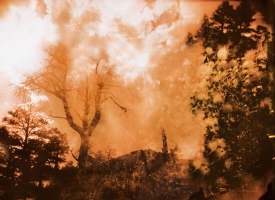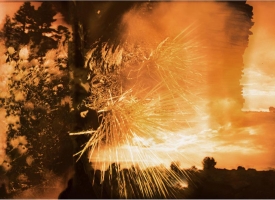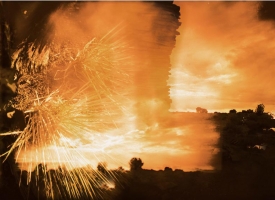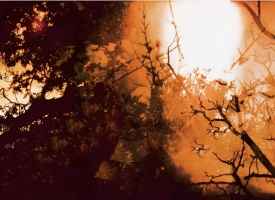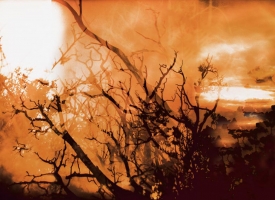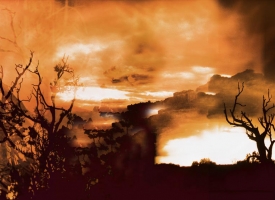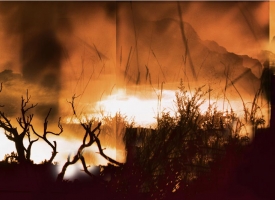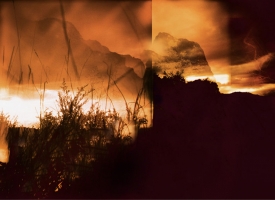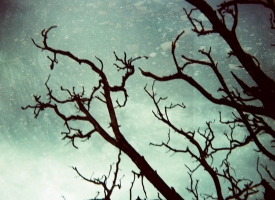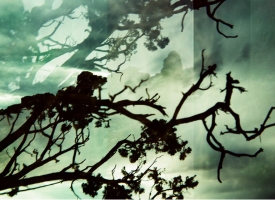WUPATKI / HOUSES OF THE ENEMIES
Project Description
Quintan Ana Wikswo’s WUPATKI / HOUSES OF THE ENEMIES is a meditation surrounding a site at the crossroads of gender, death and the desert: this point of land at the edge of the Mesozoic spone of the Grandmothers volcano field contains the home of the Spider Woman Na’ashjéii Asdzáá, crumbling pueblos, a Hopi vulvic worship site, an ancient astronomical observatory, earthquake fault lines, a volcano with its apocalyptic ash and lava fields, the current reservation of the Navajo Nation…and the vestiges of genocidal crimes against the native nations and the present-day femicides on the desert borderlands between the United States and Mexico.
WUPATKI is an interdisciplinary suite of the artist’s photographs, prose poem texts, essays, installation films, and both solo and collaborative live performance works.
Artist Statement
The buildings, civilization, and geology of Wupatki are anciently female, sexual, sacred in a way our society no longer “sees.” First encountering Wupatki with a girlfriend, my earliest experiences with the site have been within a female, sacred, sexual relationship that our society likewise refuses to “see.” Wupakti itself – like female sexuality, and queer sexuality, and the knowledge held by ancient peoples – remains misunderstood, overlooked, and obscured….not seen.
At the edge of Arizona’s Painted Desert and separated from the Navajo Nation by a shallow riverbed, Wupatki’s red-brown sandstone pueblo towers border the Mesozoic spine of The Grandmothers volcano field (also known as the San Francisco Peaks), whose vertebrae of over seven hundred volcanoes curve along nearly two thousand square miles. The strong, rounded limbs of the pueblos emerge muscular from the peaks and ravines of an earthen female form.
A millennium later, questions surround the intent of their construction and placement, deliberately gridded out along a carefully aligned map of earthquake fault lines, volcanoes, sinkholes and blowholes, celestial constellations, astronomical positions, and geological aberrations. A place of openings and explosions, creations and destructions, many people believe the predecessors to the Hopi built these pueblos amidst the lava and black ash as a shamanic worship site to a spider-like geo-goddess of creation and destruction.
The reason why I’m interested in this place is because it’s one of the few places on earth where all these lines of visibility and invisibility intersect. And I like intersections and collisions of the past into the future-present.
I’ve been creating this series of poems, photographs and films at Wupatki for over eight years, working with salvaged antique military and battlefield film cameras and typewriters. The prismatic spectrum and fragmentation of time informs my layering of image and text, exactly as they are refracted through the lenses and viscera of my damaged instruments – I don’t use any digital or software effects. The voice of these works comes from manipulating the optical and physical distortions in the equipment, and from embracing the inherent “ruin” of the instruments themselves. The chemistry and optics of these war-torn instruments record better than anything I can think of what spirals and coils at these sites—what remains, what lingers, what still exists.
I feel a bit amused by the puzzle of discussing places in a straightforward, accessible way that can be shared with others. By the time I spend years at these places and question their lost ecological and geological and spiritual and anthropological and social and gender and military histories in every way I know how, I learn an immense amount of hidden and overlooked knowledge about them. I also spend a lot of time simply looking and listening and dreaming.
Perhaps the process I undergo is one of abstraction – I start with an infinite matrix of mysteries, and then I enter it and go down and down and down and down through the grid of knowledge until it’s all a prismatic multiplicity of voices and colors and textures and sounds, and there’s nothing left that is monolithic and coherent. The narrative itself fractures, and erodes.
My body of work “The Houses of the Enemies” is, on the simplest level, a series of questions: how do we find a way to read what has been erased? How do we begin to look at what is overlooked? How do we learn to see what is unseen?
Visual Art
All photographs were created at Wupatki. The photos were made using salvaged 120mm film cameras manufactured by Kodak in the United States. The colors, textures, shapes and multiple layers within the photographs are all created using only the unique aberrations of the cameras’ optics, and the chemistry of the film. There is no software or computer manipulation in the images.
THUMBNAIL GALLERY BELOW. CLICK TO VIEW FULL-SIZE PANORAMIC IMAGES.
Literature
WUPATKI / HOUSES OF THE ENEMIES
by Quintan Ana Wikswo
First published in High Desert Journal
The man walked by and wanted to buy us. He used his language, where cadaver
rhymes with woman. We replied to him in our language, where battle rhymes
with birth – the kind that snaps bone.
O
Here is where the rocks of us lay on the lava field, dreaming of beach. Your
breasts an inverted crater, and these your thousand ocotillo ribs. Above your
nipples a guarantee: we will reach the sea.
O
There is no such thing as skin, here – we are all cinders, ash and sand and the dry
white sediment of minerals seared from your body by this wind. Your hairs raised
in sweat and steam, static against my tongue: this heat a kind of cooking. We are
rendered, braised, blackened and then consumed. Love, a flammable cache of
cholla in grass baskets. A fire startling in its need to burn.
O
You say the sky is an illusion. So hot it bends and buckles, and I want you here in
the black ash. A hundred paces away and the light has warped into a murmuring
pale muscle: this is where we climb up the rocks, and then leap off into the azure
crater of sky.
Invert it, and we’re swimming again.
O
The gnarled arms of the juniper tree. To be here and long for what we have and
what we have not. Fallen stones and sinkholes. The wind and gravity, each with
their own riptides: two forces tied to our waists, and one tethers us to the sky
and the other pinions us to the deep below. Each day we pull on them and on
each other to remind ourselves of larger forces: this tension keeps us placed.
Boulders.
O
Here, there is no such thing as sea – only a wet white seam that rips along the skin
of the desert.
O
Bird bones in the silt, half buried, and an open beak.
Between your legs are feathers, wings and claws. Your egg lies in shards at my
feet. Only half-emerged, we are already consumed by ants. We are new and
hungry and half-tangled in mucus and each moment we do not fly, we die.
O
The approach to this place is an infertile road of grit and Moenkopi. We are
bounded by lizards – tight and hardened creatures that have worn down from
who they were in the long ago. One day, that is who you will be to me, too. What
is taken from us, and the silt its shadow leaves behind.
O
In the high light of near night, we and the yucca cast shadows against the pale ash
– this mountain the corpse once called volcano. We burrow and tunnel through
the soft of it, and in the thick cool comes a hand, subterranean, knowing that here
the dark is kinder than the light.
O
Without a moon, we watch the meteors. We lie naked in the rocks and dream of
scorpions. A stab of pain and then surrender. There is no thought of kissing, of
communion. You tell me to crawl inside your skin, to inhabit you. I think of
clinging to your bones from within your flesh. It seems sweet, and safe. The
desert distills in this way, erodes us to our elements. To be inside. To seek
shelter.
Out here, death is no big deal.
O
To sleep in the sun without shelter – yesterday I slipped into dreams, thinking of
the taste of your breath. A vulnerability not far from sacrifice. Unconsciousness at
the wrong time brings the immortality of catastrophe.
The thundering slumber of this sun is something not to wake from. Impossible to
imagine: a height of heat that bends our sand to glass. A liquid that is not water.
Snakes constrict their prey in less tight an embrace than what I seek from you.
O
Petroglyphs in the cenote and craters and your body is my underworld. That
which is below ground is greater than that above. We come to being, seeds in a
thick red magma cave, and we leave through a system of passages. We all try to
climb back through, and it is because of this that I know you there now, with my
hands and lips and mouth.
O
In the dawn, the lava blocks are still heated from the day before. Underneath them
is a kind of evaporated clay – caliche. Sentimental. Damp. I reach inside your shirt
and find spines. Solitude. I open your lips with my fingers and feel fangs, and
venom, and silence. You are reptilian, and I am your hibernation.
O
Sandstone, seedpods, and the soft rise of viscera amidst hips. Pumice and
chaparral: what I piled on top of us, still breathing. Caldera. An immolation of
collarbones buckled and pinned within the spine. This place knows what it is to
wear down, to split, ignite, and then erupt.
Published in High Desert Journal
Film
Performance
Credits
Quintan Ana Wikswo’s
WUPATKI: HOUSES OF THE ENEMIES
(c) 2013
Text, Poetry, Libretto, Photography, 35mm films & concept by QUINTAN ANA WIKSWO
filmed and photographed on location at Wupatki, Arizona
text and selected images first published in HIGH DESERT JOURNAL (c) 2012
FILM PROJECTION FOR LIVE PERFORMANCE
Music by PAMELA MADSEN
Performed by Ensemble Peak FreQuency
Solveig Olsen – soprano
Jane Rigler – flute
Glen Whitehead – trumpet
Lee Gardner – bass
Sharon Skidgel – piano
Michael Woods – percussion
Colin McAllister – conductor
Premiere performance at Centennial Hall Auditorium
Visual and Performing Arts
University of Colorado, Colorado Springs
Saturday, Dec. 1st, 2012
Supported by the CU Diversity & Excellence Grant and the President’s Fund for the Humanities
The Peak FreQuency Creative Arts Collective serves as a platform for innovative, culturally diverse pursuits in music as well as interdisciplinary practices and research in sonic arts and other fields.
A resident organization of the Music Program of the Visual and Performing Arts Department (VAPA) at the University of Colorado, Colorado Springs, Peak FreQuency presents thematically designed, carefully curated concerts as well as interactive residencies with guests drawn from the international music and arts scenes that reflect both faculty and student reserach, creative work and VAPA Music curriculum directions. The 2012/2013 season will include residencies by Pauline Oliveros, Philip Blackburn, Pamela Madsen and concerts by the Ensemble Peak Frequency (EPF).


